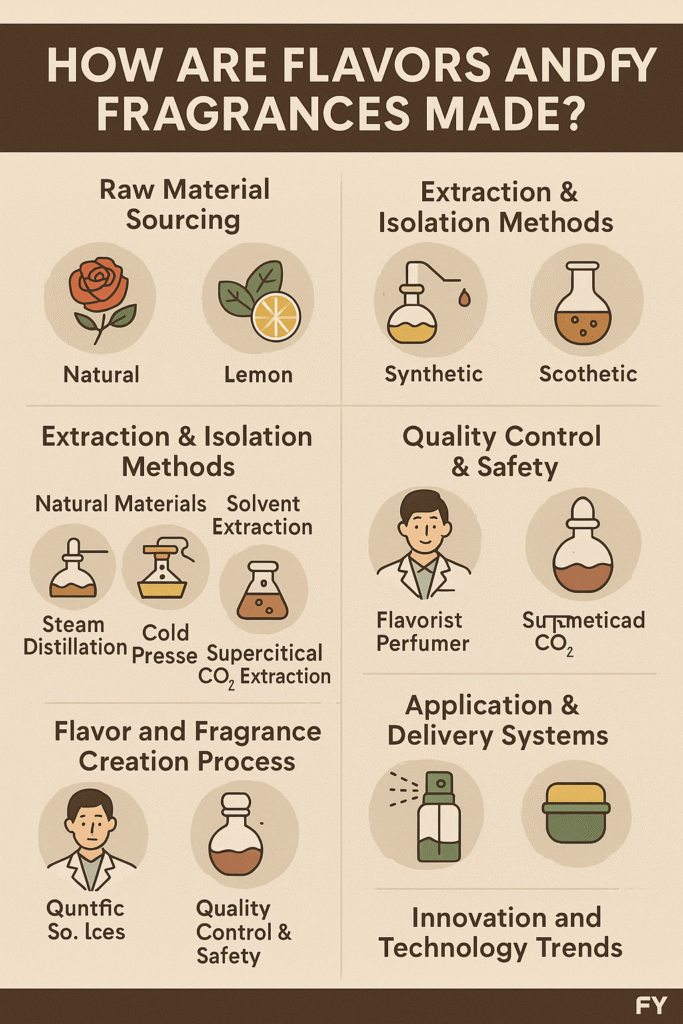🌿 How Are Flavors and Fragrances Made?
An Inside Look at the Science Behind Scent and Taste — With FY’s Expertise in Action
1️⃣ Introduction: Where Science Meets Sensory Experience
Every time you savor a juicy peach-flavored candy or inhale the fresh aroma of your fabric softener, you’re engaging with the work of flavorists y perfumers—the creative scientists behind the world of flavors and fragrances.
At FY, a global supplier of B2B fragrance and flavor solutions, we decode, design, and deliver scents and tastes that drive consumer emotion and brand loyalty — all with innovation, safety, and scale in mind.
So how exactly are these magical compounds made? Let’s dive in.
2️⃣ Raw Material Sourcing: From Nature or Labs
Whether for flavor or fragrance, production begins with raw materials — and choosing the right ones is both an art and a science.
🔸 Flavors
- Natural Sources: fruits, herbs, spices (e.g., vanilla beans, mint, citrus peel)
- Nature-identical: compounds derived via fermentation (e.g., vanillin from rice bran)
- Artificial: synthesized compounds not found in nature but safe and functional
🔸 Fragrances
- Essential oils: extracted from botanicals like lavender, rose, or sandalwood
- Aroma molecules: lab-created compounds like Hedione o Iso E Super
- Animalic notes: historically used ambergris or musk — now largely synthetic
🔬 At FY, we carefully vet all raw materials for safety, performance, and regulatory compliance — including IFRA, REACH, and regional food safety standards.
3️⃣ Extraction & Isolation Methods
Different materials require different extraction techniques to preserve aroma or taste integrity:
- Steam Distillation: used for essential oils (e.g., eucalyptus, lemon oil)
- Cold Pressing: used for citrus oils like lime or bergamot
- Solvent Extraction: for fragile flowers like jasmine or tuberose
- CO₂ Supercritical Extraction: high-purity, solvent-free, eco-friendly
- Fermentation & Bioconversion: emerging biotech solutions for sustainable aroma molecules
FY integrates green extraction technologies to minimize environmental impact while maintaining ingredient purity.
4️⃣ Chemical Synthesis for Consistency & Innovation
Many modern flavors and fragrances are sintético — not due to cost-cutting, but because they are:
- More stable
- Easier to scale
- Consistent batch-to-batch
- Safer when allergens or instability are an issue
Example:
- Ethyl vanillin (synthetic): 3x stronger than natural vanillin, often used in vanilla flavors
- Linalool (synthetic or natural): a lavender-scented compound common in soaps
FY’s R&D team uses GC-MS analysis and digital scent mapping to design both sintético y nature-identical solutions tailored to market needs.
5️⃣ Formulation & Blending: The Art of Balance
At the heart of every flavor or fragrance is a carefully crafted formula.
➤ Fragrance Blending
Perfumers at FY balance top, hearty base notes using fixatives, carriers, and creative intuition. These formulations are tested in real product bases — from detergents to skin care emulsions — to ensure stability and olfactive performance.
➤ Flavor Development
Flavorists design for:
- Volatility and release in heat or cold
- Mouthfeel and sweetness modulation
- Aftertaste control for beverages, gums, and more
All flavors are evaluated using trained sensory panels and GC-O analysis (Gas Chromatography-Olfactometry).
6️⃣ Encapsulation & Delivery Technologies
To ensure longevity, stability, and targeted release, flavors and fragrances are often encapsulated:
- Microencapsulación: for laundry beads and detergent scents
- Spray-drying: for powdered drink flavors
- Gelatin capsules: for flavor bursts in candies
- Slow-release beads: for home and air care products
FY offers advanced encapsulation solutions for fabric care, beverages, oral care, and more.
7️⃣ Safety, Compliance & Quality Control
Ensuring safety is non-negotiable. FY rigorously follows:
✅ For Flavors
- FEMA GRAS certification (U.S.)
- EU Regulation 1334/2008
- Organoleptic + toxicological testing
- Heavy metal & solvent residue analysis
✅ For Fragrances
- IFRA Compliance (International Fragrance Association)
- REACH registration (EU)
- Allergen declarations
- Stability and compatibility testing across pH, surfactants, alcohol, etc.
8️⃣ FY’s Innovation: Sustainability in Scent & Taste
FY is committed to sustainable manufacturing, including:
- Using upcycled ingredients (e.g., citrus peel waste into limonene)
- Offering biodegradable fixatives and green solvents
- AI-assisted formulation platforms for predictive prototyping
- Digital GC-MS scent matching for reducing development cycles
From raw material to shelf-ready scent, FY ensures every step is transparent, safe, and built for the future.
9️⃣ Conclusion: The Journey from Molecule to Emotion
Creating a flavor or fragrance is not just about chemistry — it’s about evoking emotion, enhancing product experiencey amplifying brand identity.
At FY, we combine science, artistry, and decades of experience to help brands around the world craft sensory signatures that stick in memory and build loyalty.
📩 Want to co-create your next signature scent or flavor?
Contact FY for custom formulation, sampling, and global regulatory support.
❓ Friendly FAQ Section
🔸 What’s the difference between natural and synthetic fragrances?
Natural fragrances come from essential oils and extracts; synthetics are lab-made molecules. Both can be safe and effective when used correctly.
🔸 Are synthetic flavors safe to consume?
Yes — synthetic flavors like ethyl vanillin are FEMA GRAS-approved and undergo strict food safety testing.
🔸 How does FY ensure fragrance safety?
FY follows IFRA Standards, allergen declarations, and global compliance (REACH, SDS, etc.), with in-house GC-MS and patch testing for formulation integrity.
🔸 Can I request a custom fragrance or flavor from FY?
Absolutely. FY offers tailored scent/flavor design, including sampling, matching, and localized regulatory documentation.
